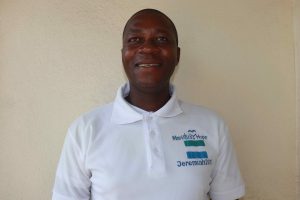In Mahera, 386 people depend on one well that suffers from constant breakdowns. The community is constantly paying to have it fixed, but with no lasting solutions. This has left everyone getting water from wherever they can - from other communities, where they must pay water fees (on top of the ones they've already paid for their own well), or from the contaminated swamp.

"Sometimes the pump [does] not provide enough water, and when I need water to complete my domestic activities, I fetch water from the stream," said 40-year-old farmer Santo Turay (carrying water from the swamp in the photo above). "Fetching water from the stream is not easy. Sometimes the stream water will be dirty to use, and it could take more time to get clean water."
The water crisis impacts Santo's effectiveness as a farmer because she needs to spend so much time in her day fetching water. "I need water to cook, bathe, clean the house and, as well, look for drinking water," Santo said. "I go to the farm late because I spend [a lot of] time fetching water, which delays the time of my farm work."

The swamp stream is open to animal and environmental contamination, but it is also frequently used for bathing and laundering clothes so that people won't need to carry the water all the way back to their homes. It is also located close to community members' farms, meaning fertilizers seep into the water. These practices further contaminate the water everyone must later drink, and not all contaminants can be eradicated by boiling.
15-year-old Zainab (fetching water in the photo above and posing in the photo below) dislikes fetching water from the swamp. The way to the stream is hilly and slippery, and sometimes people get bitten by snakes or scorpions on the way - and that's not even mentioning the quality of the water. "[The stream water] is dirty to use, and [we] only use it to launder clothes, bathe and to irrigate farm vegetables like onions, garden eggs (eggplant) and peppers."

Zainab also said she misses a lot of school, either due to being tired from fetching water or from water-related illnesses. "At times I cannot go to school, because of the distance I have walk to fetch water from the stream," she said. "More especially, when my mother is about [watering] the onions, okra, and pepper beds, after applying fertilizer, it causes me to [be] sick."
"It is not comfortable living in this community without enough safe drinking water," Santo concluded. "This water point is not providing enough water for us. This is the main problem that is limiting my daily activities."
A rehabilitated well will provide enough water to serve everyone in the community, and with our monitoring and maintenance program, those frequent pump breakdowns will be a thing of the past. The people of Mahera should find they have more time and energy, and better health.
Here’s what we’re going to do about it:
Well Rehabilitation
The well marked for this overhaul is dry for a few months every year and needs major work to supply adequate, clean water to the community year round. The pump will be removed, and a hand auger will be lowered inside and powered by a drill team. This hand auger will allow the team to drill several meters deeper to hit a sufficient water column that will ensure the well supplies water throughout all seasons.
As the team drills, casing will be installed, transforming the bottom of this hand-dug well into a borehole. PVC piping will connect this lower system directly to the pump, a construction that we know will also improve the quality of water.
Once this plan is implemented, everyone within the community will have access to safe drinking water in both quality and quantity, even through the dry months.
Hygiene and Sanitation Training
There will be hygiene and sanitation training sessions offered for three days in a row.
After our visit, the hygiene and sanitation trainer decided it would be best to teach community members how to build a tippy tap (a hand-washing station built with a jerrycan, string, and sticks). They will use these tippy taps for handwashing demonstrations, and will also teach about other tools like dish racks and the importance of properly penning in animals.
These trainings will also strengthen the water user committee that manages and maintains this well. They enforce proper behavior and report to us whenever they need our help solving a serious problem, like a pump breakdown.

 Borehole Well and Hand Pump
Borehole Well and Hand Pump















